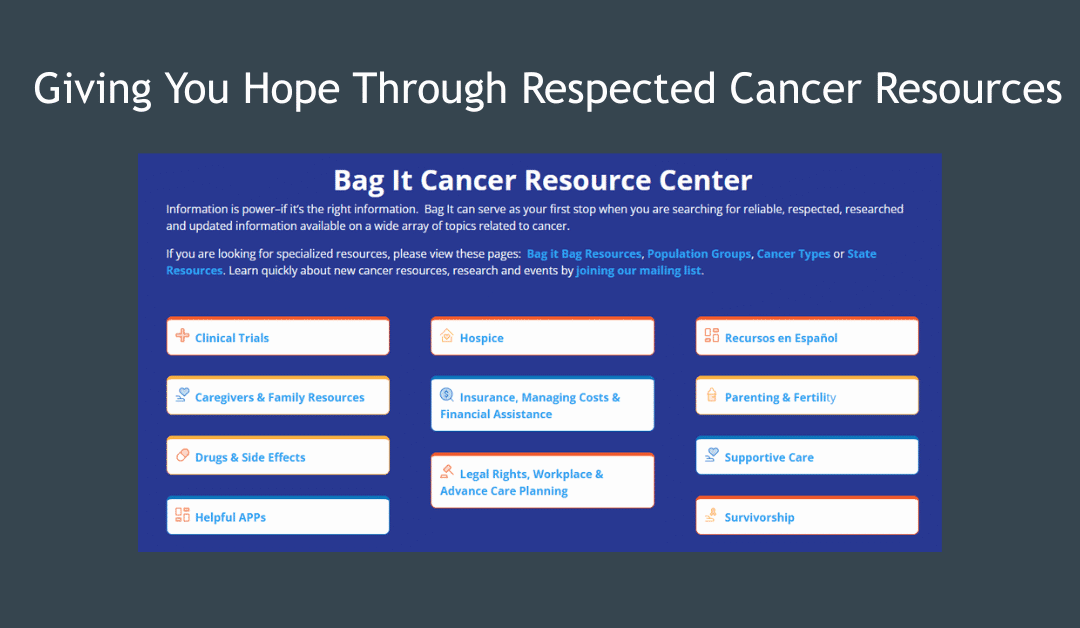
by Bag It Team | Jul 7, 2025 | Educational Articles
Explore the Bag It Cancer Resource Page
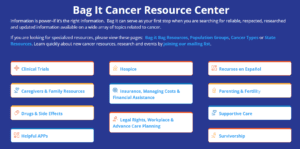 Navigating a cancer diagnosis—whether it’s your own or a loved one’s—can feel overwhelming. That’s why Bag It Cancer is committed to making the journey a little easier with trustworthy, accessible resources all in one place.
Navigating a cancer diagnosis—whether it’s your own or a loved one’s—can feel overwhelming. That’s why Bag It Cancer is committed to making the journey a little easier with trustworthy, accessible resources all in one place.
The Bag It Cancer Resource Center is thoughtfully curated to support patients, caregivers, and healthcare providers at every stage. Whether you’re looking for guidance on supportive care, emotional support, survivorship, caregiver tools, or community connections, you’ll find credible organizations and up-to-date information right at your fingertips.
This free, easy-to-navigate hub includes links to national resources across a range of topics—financial help, clinical trials, mental health, and more. It’s an extension of the support offered through our Bag It Bags, helping you stay informed and empowered beyond the doctor’s office.
We encourage you to visit our Resource Center and share it with anyone who may benefit. At Bag It, we believe that information is power—and hope.
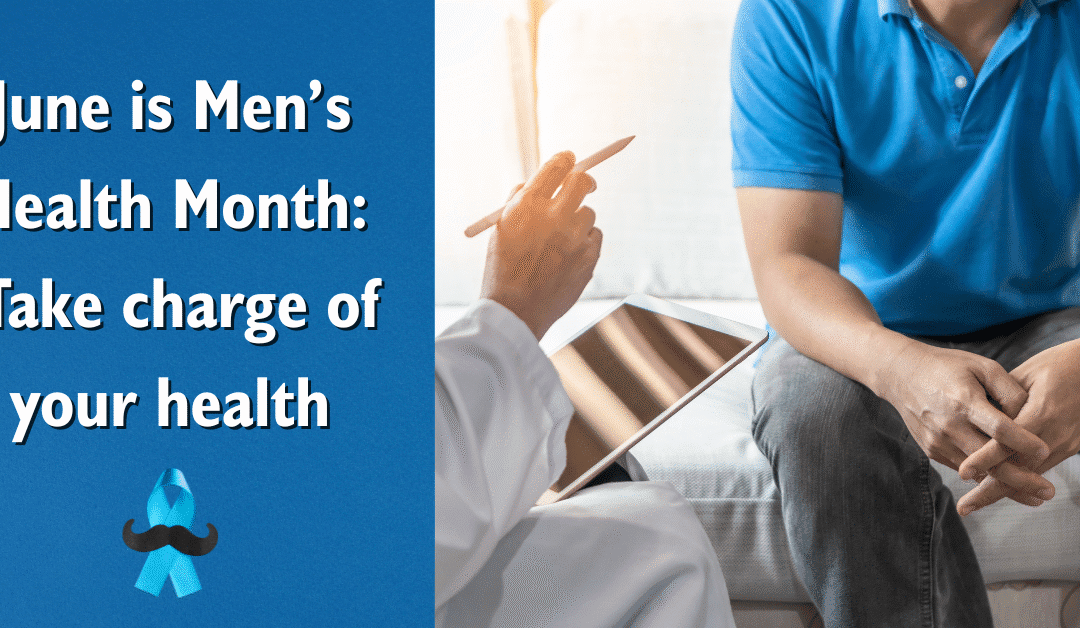
by Bag It Team | May 30, 2025 | Educational Articles
June marks Men’s Health Month, a time to raise awareness about preventable health problems and encourage early detection and treatment of disease among men and boys. At Bag It, we recognize how important it is to empower men with the tools and information they need—especially when facing a cancer diagnosis.
Cancer & Men: Know the Risks
 Men are more likely than women to be diagnosed with cancer and have a higher mortality rate. The most common cancers affecting men in the U.S. are:
Men are more likely than women to be diagnosed with cancer and have a higher mortality rate. The most common cancers affecting men in the U.S. are:
- Prostate cancer
- Lung cancer
- Colorectal cancer
- Bladder cancer
- Melanoma
Early detection is key. Men often delay routine checkups or ignore early symptoms. Regular screenings can catch issues before they become serious.
Tips for Taking Charge of Your Health
- Schedule annual checkups – Even if you feel fine, regular visits can help detect problems early.
- Know your family history – Some cancers run in families; talk with your doctor about any history of cancer.
- Get screened – Discuss appropriate cancer screenings with your provider (especially for prostate, colorectal, and skin cancer).
- Live healthy – Eat well, stay active, limit alcohol, don’t smoke, and protect your skin from the sun.
- Talk about it – Encourage the men in your life to prioritize their health, too.
How Bag It Cancer Can Help
If you or someone you know has been diagnosed with cancer, our Bag It Bag provides reliable, easy-to-understand materials to help patients feel informed, empowered, and organized. Men may not always ask for help—but they deserve support, too.
Let’s break the silence around men’s health and encourage the men in our lives to take action today.
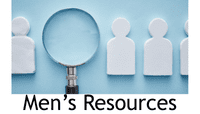
Resources
General Men’s Health & Preventive Care
- Men’s Health Guidelines for Screening
- Men’s Health Month (Men’s Health Network) – Information, health facts, and advocacy resources dedicated to men’s health.
- CDC – Men’s Health – Covers key health risks, preventive steps, and tips for staying healthy.
Support for Men Facing Cancer
- Bag It – Get a Bag – Free resources to help patients feel informed, empowered, and organized.
- ZERO – The End of Prostate Cancer – Support, education, and advocacy specifically for those impacted by prostate cancer.
- COLONTOWN – A patient-led community for colorectal cancer
- GO2 for Lung Cancer – Education, screening & support for lung cancer
- CancerCare – Support for Men – Support groups, counseling, and educational workshops for men affected by cancer.
- Cancer Support Community – For Men – Emotional and practical support specifically geared toward men
Bag It Bags for Specific Cancers
- Prostate Cancer – Bag It and ZERO Prostate Cancer have partnered to develop 2 Bags of essential resources for patients and caregivers impacted by Advanced-Stage and Early-Stage Prostate Cancers.
- Colorectal Cancer –Bag It and Colontown have partnered to develop this Bag of essential resources for patients and caregivers impacted by colorectal cancer (CRC).
- Lung Cancer – Bag It and GO2 for Lung Cancer have partnered to develop this Bag of essential resources for patients and caregivers impacted by Lung Cancer.
Explore other Bag It Cancer-specific Bags.
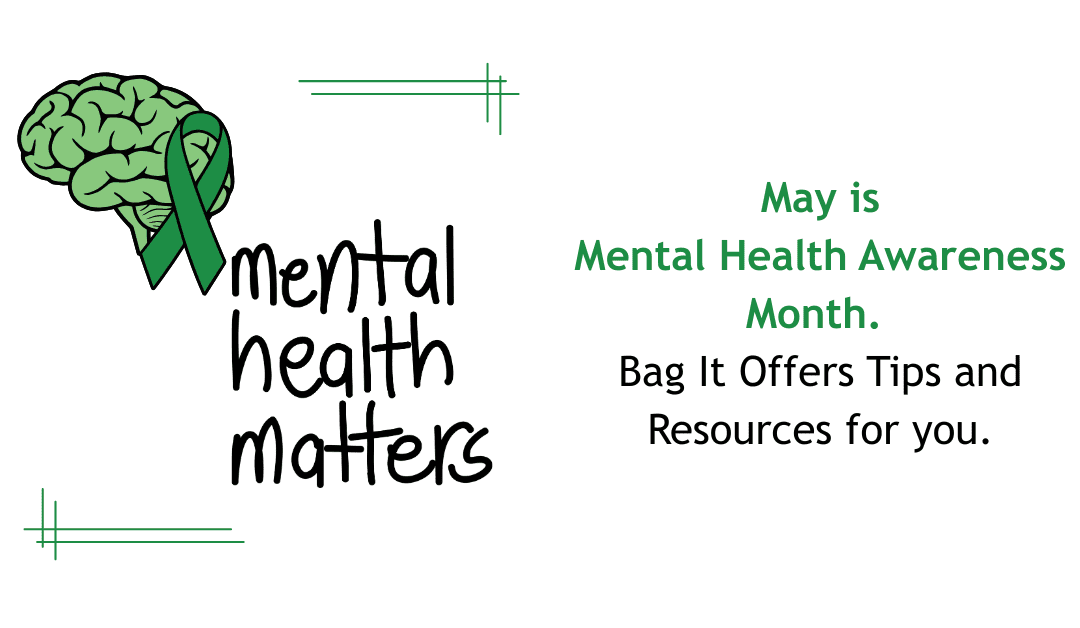
by Bag It Team | Apr 29, 2025 | Educational Articles
May is Mental Health Awareness Month, a time to pause and reflect on how we care for our emotional well-being—something that affects all of us, no matter our background or health status.
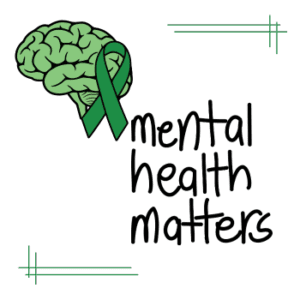 At Bag It Cancer, we work every day to support those impacted by cancer, and we see firsthand how critical mental health is throughout the journey. But the truth is, everyone faces stress, uncertainty, and emotional challenges at different points in life—whether you’re navigating a diagnosis, caring for a loved one, or simply managing the pressures of daily life.
At Bag It Cancer, we work every day to support those impacted by cancer, and we see firsthand how critical mental health is throughout the journey. But the truth is, everyone faces stress, uncertainty, and emotional challenges at different points in life—whether you’re navigating a diagnosis, caring for a loved one, or simply managing the pressures of daily life.
Mental health is health. It deserves our attention, our compassion, and our time.
Here are a few small ways anyone can support their mental well-being this month:
- Take a mindful break. A few minutes of quiet breathing or stepping outside can reset your mood.
- Connect with someone. A conversation with a friend or loved one can make a big difference.
- Practice kindness—especially toward yourself. Let go of perfection and embrace progress.
If you or someone you know is in emotional distress or crisis, help is available. Call or text 988 to reach the Suicide & Crisis Lifeline—free, confidential support 24/7/365.
Looking for helpful mental health tools?
Here are a few trusted resources:
CancerCare: Coping with Cancer
Mental Health America: Mental Health Month Toolkit
Headspace: Free Mindfulness Tools
Caring for your Mental Health
Whether you’re a patient, caregiver, donor, or part of our extended community—thank you for standing with Bag It. Let’s continue supporting the whole person—mind, body, and spirit.
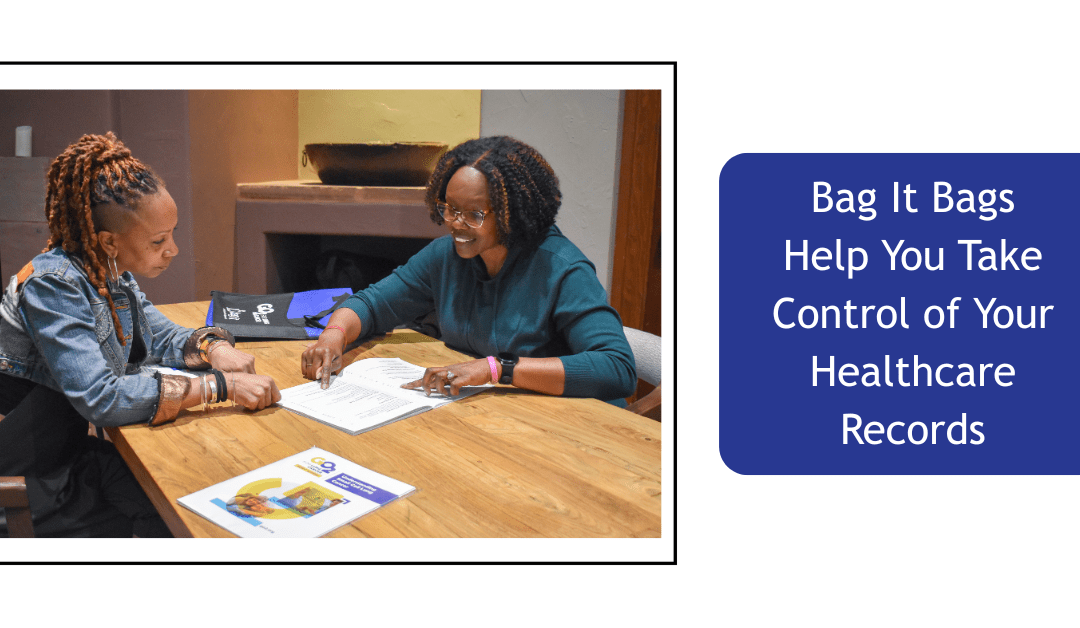
by Bag It Team | Apr 7, 2025 | Educational Articles
Why It Matters & How Bag It Can Help
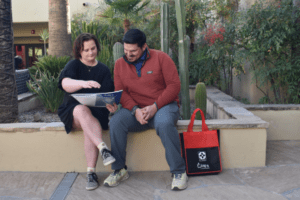 March is Records Management Month—a perfect time to assess how you organize and manage your healthcare records. Whether you’re navigating a new diagnosis, managing a chronic condition, or simply keeping up with routine checkups, having your medical records organized can save time, reduce stress, and empower you to be an active participant in your care.
March is Records Management Month—a perfect time to assess how you organize and manage your healthcare records. Whether you’re navigating a new diagnosis, managing a chronic condition, or simply keeping up with routine checkups, having your medical records organized can save time, reduce stress, and empower you to be an active participant in your care.
Why Keep Your Healthcare Records Organized?
Medical records contain essential details about your health history, including test results, treatment plans, medications, and doctor’s notes. Keeping track of these documents helps you:
- Ensure accurate and consistent care – Having records readily available helps healthcare providers make informed decisions.
- Prevent duplicate tests and procedures – Access to past test results can save time, reduce costs, and avoid unnecessary procedures.
- Monitor progress and advocate for yourself – Tracking treatment plans, medications, and symptoms allows for better communication with your medical team.
- Prepare for emergencies – Quick access to records can be crucial in urgent situations, especially when visiting new doctors or specialists.
How a Bag It Bag Can Help
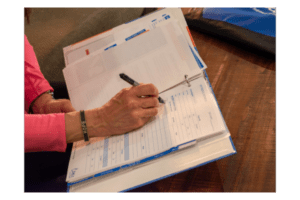 At Bag It Cancer, we understand that managing medical information can be overwhelming. That’s why every Bag It bag includes a My Companion Guidebook, a simple and effective tool designed to help patients and caregivers organize their healthcare journey. Inside, you’ll find:
At Bag It Cancer, we understand that managing medical information can be overwhelming. That’s why every Bag It bag includes a My Companion Guidebook, a simple and effective tool designed to help patients and caregivers organize their healthcare journey. Inside, you’ll find:
✔ Tabbed sections to sort medical records, test results, and insurance information.
✔ Prompted pages for recording doctor visits, questions, and treatment details.
✔ Resources to help you understand your diagnosis, treatment options, and survivorship care.
Whether you’re dealing with cancer or another serious health condition, staying organized gives you confidence and control. This Records Management Month, take the time to gather, review, and organize your healthcare records. And if you or someone you know could benefit from a Bag It bag, visit [Bag It Cancer’s website] to learn more.
For more tips, read this story from our April 2022 Newsletter.
Be Empowered. Be Engaged. Bag It!
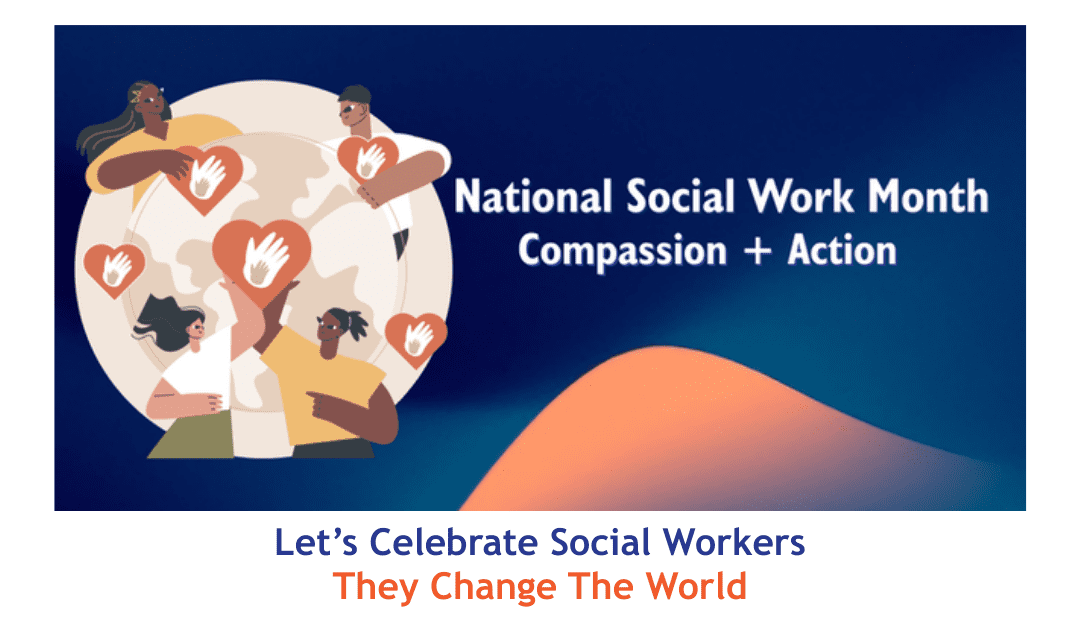
by Bag It Team | Mar 10, 2025 | Educational Articles
 March is Social Work Month and this year’s theme is Social Work: Compassion + Action. Individuals who enter the social work field don’t do it for the fame or glory, they enter the profession because they care. They care about people, policies, and advocacy. Social Work Month allows us to celebrate these special people who often go unseen but are so vitally important.
March is Social Work Month and this year’s theme is Social Work: Compassion + Action. Individuals who enter the social work field don’t do it for the fame or glory, they enter the profession because they care. They care about people, policies, and advocacy. Social Work Month allows us to celebrate these special people who often go unseen but are so vitally important.
You may not realize it but social workers are everywhere! They work in clinical settings, hospitals and medical offices, in schools and community centers, in child protection and legal realms and in public policy spaces. There are over 700,000 social workers in the United States. Despite years of education, training and multiple certifications, social work is also one of the fastest-growing occupations, and these empathic individuals are in high demand.
One branch of social work near and dear to Bag It is medical social work — especially those in the oncology space. Oncology social workers support patients from “you have cancer” into survivorship. They provide assessments, assist with resource navigation, help with life and memory planning, and, most importantly, they offer emotional support. Oncology social workers are there during the hard conversations with providers and remain with you after to offer kindness, empathy and support. They are the middleman between the medical team and the patient and their family. In a space where everyone else is focused on the cancer, the social worker is focused on YOU — your quality of life, your hopes, dreams, and wishes, and your feelings and opinions.
Social work can be an amazingly rewarding profession. Regardless of the setting they work in, they go in each day knowing their goal is to help others, to improve lives and enhance well-being. Working with diverse populations helps you learn more about the communities we exist in, the varying needs and about yourself. There are endless positives to social work. And, simultaneously, it can be one of the most difficult professions. Social workers see the world at its best and at its worst, they see people at their happiest and their saddest, at the beginning of their lives and at the end. There is heartache and trauma in this work because there are barriers beyond our control. But they return to work, to the front lines of the human experience, day after day.
Here are some additional resources about how Social Workers can help you and your caregiver.
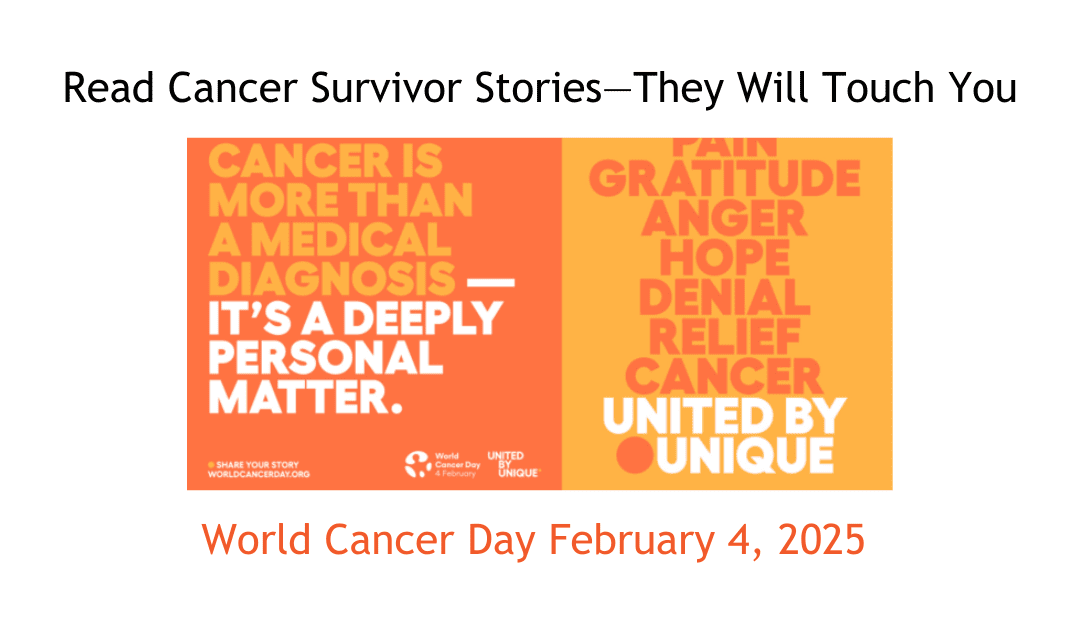
by Bag It Team | Feb 11, 2025 | Educational Articles
February 4th was World Cancer Day. The theme for 2025-2027 is United by Unique.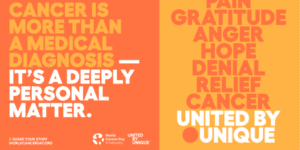
Each person’s story from diagnosis and beyond is different and each one matters! We receive different diagnoses, advice, treatment plans, drugs, surgeries, care, etc. But cancer is so much more than just a diagnosis.
We go through different emotions and at different paces. We learn so much about ourselves and those we care about. We discover how unique we truly are. Yet in our individuality, comes a kinship. Our story is ours, yet it will resonate with another’s heart.
We are extremely grateful to our Escape to THRIVE participants who were willing to share some of their stories that may touch your heart, may help you find something you’ve been missing, or may just be what you needed to hear to know that you are not alone.
Sharing Cancer Stories
It’s world cancer day today and I am so privileged to still be here while so many of my beautiful friends are not. Today I am so so lucky to be a stage 3C TNBC survivor because there were moments (shit there are still moments) where this crap is so heavy. Being diagnosed young and when you are supposed to be building a family, a home, a future sucks but I’m also thankful, I’m thankful for the compassion and desire to overcome what cancer has taught me. I’m thankful to the doctors and nurses and medicine that saved my life in 2021 so I can be here with no evidence of disease 4 years later. I’m thankful for the perspective cancer has given me not only on life but also death. Most of all I’m thankful for the community cancer helped form for me. A group of other compassionate, powerful, strong, intelligent humans all with this same crappy connection.
—Kimberly
This World Cancer Day I’m choosing to focus on the word grateful. That may seem odd when talking about a cancer diagnosis and, trust me, my heart has not filled with gratitude every day of this journey. I’ve had (and have) many days I look at the changes in my body and I wonder why this happened. But, as difficult as the journey has been at times, it has brought so much to be grateful for into my life.
I am grateful that my cancer was found early. I am grateful that I had an amazing team of doctors who worked together for the best outcomes possible. I am grateful for the family and friends that surrounded me and supported me throughout 7 surgeries and recoveries, especially my saint of a husband. I am grateful for the new friends I have gained in my life from joining a cancer group. And I am grateful for the opportunity I have to give back to those on this journey.
—Amy

This World Cancer Day, I focus on being. In a world full of doing, cancer was a wake up call for me to slow down and just be. Even when I had all the intention in the world to “do” my work continuing education credits during my month long surgery recovery, my body had other plans. I literally could do very little beyond look out the window. Even taking a walk was a momentous event. Slowly, my physical strength came back, and my spiritual and mind space expanded beyond where it had ever been before cancer. Cancer changed my life for the better (I can only say this many years into my thrivership).
I learned to:
- appreciate me for who I am, not the things that I do
- be graceful in accepting help (realizing it is a gift to give, and in order for someone to give help, someone must receive).
- slow down and not do everything everywhere all at once, especially for everyone else
- take time for myself
- advocate for myself and other cancer thrivers
- do the things that I enjoy, including retreats
- meditate
- be even more grateful
- savor each moment, even the challenging ones
- appreciate that growth comes from the seemingly hardest experiences
- heal with nature
Thank you to all of you who have shared in my journey. I am inspired by you. I appreciate you. I am grateful.
—Su-Yen

I see my life in 2 distinct halves: BC and AC—before cancer and after cancer.
I don’t even know that girl BC anymore. It’s as if she once existed and then she…didn’t. Maybe she died all at once while our body was in an icu bed, in a coma, tubes coming from her face, arms tethered, voiceless but wanting to scream, aware but not understanding, asleep but knowing even as she was being drugged into oblivion… Maybe she died little by little, piece by piece, as she lost body parts, left on operating room floors. Maybe she went mad and jumped off a building somewhere. No one noticed she was gone, except me. But I know. I know she’s dead and gone and I cannot deny that the me left in her place is brand new.
AC me has the wisdom that other me never grew old enough to attain. Expansiveness that other me could never begin to comprehend. She is more whole than she was before the mutinous body parts were cut away. She knows love like it’s a way of life. She drinks in experiences like they’re life-giving water. She knows her life purpose like it was tattooed on her soul.
She lives her life as if it is not a promise at all, but a blessing.
—Dawn

I was trained in journalism and beginning in 1984 became attracted to educating patients so they could be more in control of their care. That consumerism was new. In 1996 it became much more personal for me when I was diagnosed with leukemia. Other patients connected me with specialists far from my home and I entered a clinical trial that worked! That survival fueled even more passion to help inform patients and that has propelled me for decades. I feel the reason I survived was for this purpose and it is thrilling to see how better informed patients get better care.
I am 74 years old now and the blood cancer I have, myelofibrosis, is somewhat progressive. But I am NOT slowing down. We patients can help each other and I am delighted to be an active part of the cancer community and help amplify key information that is significant. I believe progress is real and we patients are integral to making it happen!
—Andrew

 Navigating a cancer diagnosis—whether it’s your own or a loved one’s—can feel overwhelming. That’s why Bag It Cancer is committed to making the journey a little easier with trustworthy, accessible resources all in one place.
Navigating a cancer diagnosis—whether it’s your own or a loved one’s—can feel overwhelming. That’s why Bag It Cancer is committed to making the journey a little easier with trustworthy, accessible resources all in one place.

 Men are more likely than women to be diagnosed with cancer and have a higher mortality rate. The most common cancers affecting men in the U.S. are:
Men are more likely than women to be diagnosed with cancer and have a higher mortality rate. The most common cancers affecting men in the U.S. are:

 At Bag It Cancer, we work every day to support those impacted by cancer, and we see firsthand how critical mental health is throughout the journey. But the truth is, everyone faces stress, uncertainty, and emotional challenges at different points in life—whether you’re navigating a diagnosis, caring for a loved one, or simply managing the pressures of daily life.
At Bag It Cancer, we work every day to support those impacted by cancer, and we see firsthand how critical mental health is throughout the journey. But the truth is, everyone faces stress, uncertainty, and emotional challenges at different points in life—whether you’re navigating a diagnosis, caring for a loved one, or simply managing the pressures of daily life.
 March is Records Management Month—a perfect time to assess how you organize and manage your healthcare records. Whether you’re navigating a new diagnosis, managing a chronic condition, or simply keeping up with routine checkups, having your medical records organized can save time, reduce stress, and empower you to be an active participant in your care.
March is Records Management Month—a perfect time to assess how you organize and manage your healthcare records. Whether you’re navigating a new diagnosis, managing a chronic condition, or simply keeping up with routine checkups, having your medical records organized can save time, reduce stress, and empower you to be an active participant in your care. At Bag It Cancer, we understand that managing medical information can be overwhelming. That’s why every Bag It bag includes a My Companion Guidebook, a simple and effective tool designed to help patients and caregivers organize their healthcare journey. Inside, you’ll find:
At Bag It Cancer, we understand that managing medical information can be overwhelming. That’s why every Bag It bag includes a My Companion Guidebook, a simple and effective tool designed to help patients and caregivers organize their healthcare journey. Inside, you’ll find:
 March is Social Work Month and this year’s theme is Social Work: Compassion + Action. Individuals who enter the social work field don’t do it for the fame or glory, they enter the profession because they care. They care about people, policies, and advocacy. Social Work Month allows us to celebrate these special people who often go unseen but are so vitally important.
March is Social Work Month and this year’s theme is Social Work: Compassion + Action. Individuals who enter the social work field don’t do it for the fame or glory, they enter the profession because they care. They care about people, policies, and advocacy. Social Work Month allows us to celebrate these special people who often go unseen but are so vitally important.


Recent Comments